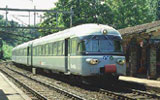 |
Tahoe
Valley Lines |
|
374 - A Proposal for US and Global Transport Policy Reliance solely on the profit motive to effect the transition from fossil driven transportation will not include re-emphasis of rail transport. This is because the USA rail freight component has become the least subsidized transport mode, resulting in a severe abandonment of the branch network and redundancies. The decline of oil from depletion requires a vast expansion of rail capacity and reach, and will demand new funding mechanisms. The US Federal Reserve can initiate, with UN/World Bank replication, "ENERGY INDEPENDENCE BONDS", modelled after WWII War Bonds. The intention is to provide seed money for an energy efficient rail network and the generation of renewable energy, linked to rail expansion. ASPO has suggested oil consumption taxes, which allow for present transport policy to approach a cost-benefit equilibrium. The Energy Independence Bonds will be a National funding mechanism for the re-orientation of the actual transportation infrastructure, being needed to provide substitute commercial transport capacity and maintain societal cohesion in scenarios of diminishing energy. This will be a time of testing leadership nerve and skill, guarding against the temptation to extract a few extra years from the status quo. To borrow from aviation, we are in for a hard landing because we are already in "Fossils Overshoot" mode, due to the inability to maintain USA per-capita energy consumption regardless of what we do. Delay in effecting changes will result only in a more difficult time when the shortfalls take place. Generic railway is treated here as a strategic "Second Dimension" of surface transport, and is seen as an apolitical logistics platform, independent from the disruptions taking place in motor transport. The planning for this period must pay especial attention to the depot and warehousing/delivery trucking interface. Rail connectivity to renewable power is simply accomplished, without fuel cell or battery, and brings the economy of large scale to renewable industry. Route planning builds on expansion of existing railways, replacement of abandoned branch corridors, and extension of reach as needed in a case-by-case determination. This is applicable worldwide, and captures the ability to mass-produce interchangeable rail components for worldwide use. Russia?s wide gauge is however a notable exception. Would Middle East Railways linked to renewable energy be a peacemaker? The new rail corridor construction will look at demographics and consider energy. For example: the US 50 corridor between Sacramento, California and Carson/Reno, Nevada, justifies a new railway line, particularly with megawatts of hydropower coming from the American River, handily found en route. The hard point of decision will be faced worldwide when highway expansion reaches a plateau, and railway becomes the focus. There are wild areas to which pavement may extend, but the era of unlimited road expansion has ended. Of course, this discussion does not take away from research and development underway, but should alert readers to the fact that rail offers proven energy savings that must be a paramount consideration to the United States. It is worth repeating that a train is the car's best friend, and this can be inclusive of agriculture and economic well-being as well. Ability to move about is a most important part of human life, and must focus on sustainability. |



